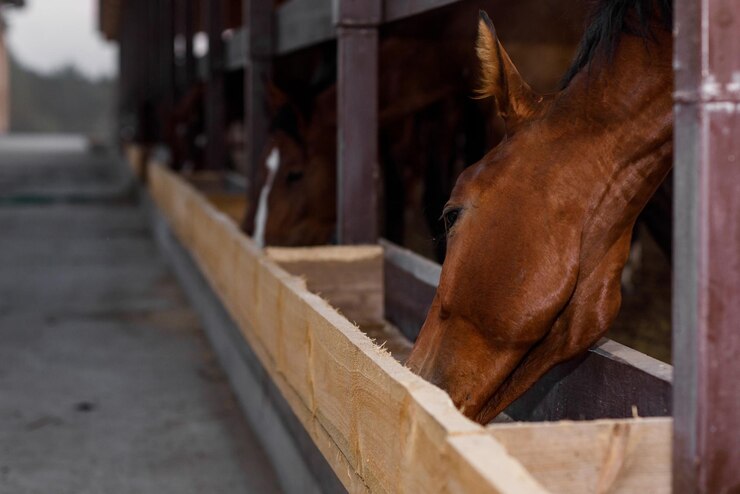Creating a homemade horse feed mix can be a rewarding and beneficial endeavor for both you and your horse. Many equestrian enthusiasts are turning to homemade mixes to ensure their horses receive the best possible nutrition tailored to their specific needs. By understanding the components of a balanced diet and incorporating the right ingredients, you can provide your horse with a healthy, cost-effective feed option. In this article, we will explore how to craft the ideal feed mix, ensuring your horse thrives.

The Importance of a Balanced Diet for Horses
A balanced diet is crucial for maintaining the health and performance of your horse. Horses require a variety of nutrients to support their energy, growth, and overall well-being. By creating a homemade horse feed mix, you have control over the ingredients and can adjust them based on your horse’s age, activity level, and health conditions.
Essential Components of a Homemade Feed Mix
1. Energy Sources
Horses need energy-dense foods to fuel their daily activities. Grains such as oats, barley, and corn are common energy sources. Ensure that these grains are cleaned and processed appropriately to prevent digestive issues.
2. Protein Sources
Protein is vital for muscle development and repair. Ingredients like alfalfa, soybean meal, and flaxseed are excellent protein sources for your homemade horse feed mix.
3. Vitamins and Minerals
Vitamins and minerals play a critical role in maintaining your horse’s health. Consider adding a vitamin and mineral supplement to meet these nutritional needs. You can learn more about essential minerals like zinc for horses for further insights.
4. Fiber Sources
Fiber is necessary for proper digestion. Hay, beet pulp, and bran are excellent sources of fiber that can be included in your feed mix.
Crafting the Perfect Homemade Horse Feed Mix
Understanding Your Horse’s Needs
Before creating a feed mix, it’s important to understand your horse’s specific dietary needs. Factors such as age, weight, activity level, and health conditions should be considered.
Choosing the Right Ingredients
Select ingredients that align with your horse’s dietary needs. Ensure that the ingredients are fresh, clean, and free from contaminants. Some horses may have allergies or sensitivities, so it’s essential to monitor their reactions to new ingredients.
Mixing and Storing Your Feed
Once you’ve selected your ingredients, mix them thoroughly to ensure an even distribution of nutrients. Store the mix in a cool, dry place to maintain freshness. Check regularly for signs of spoilage or contamination.
Benefits of Homemade Horse Feed Mix
Creating a homemade horse feed mix offers several benefits. It allows you to tailor the diet to your horse’s needs, provides fresher ingredients, and can be more cost-effective than commercial options.
Cost-Effectiveness
By purchasing ingredients in bulk and mixing your own feed, you can reduce the overall cost of feeding your horse. This approach also minimizes waste, as you can adjust the quantities to suit your horse’s consumption.
Customization
Homemade feed mixes allow you to customize the diet based on your horse’s evolving needs. Whether your horse requires more energy, protein, or vitamins, you have the flexibility to make adjustments.
Potential Challenges and How to Overcome Them
Ensuring Nutritional Balance
One of the challenges of creating a homemade feed is ensuring that it meets all of your horse’s nutritional requirements. Consider consulting a veterinarian or equine nutritionist to develop a balanced formula.
Quality Control
Maintaining the quality of your ingredients is crucial. Regularly inspect your feed mix for signs of spoilage, mold, or pests. Proper storage can help mitigate these risks.
Monitoring Your Horse’s Health
Regularly monitor your horse’s health and performance to ensure the feed mix is meeting their needs. Adjust the ingredients or quantities as necessary, and consult a professional if you notice any changes in your horse’s behavior or condition.
Feeding Tips and Best Practices
Gradual Transition
When introducing a new feed mix, transition gradually over several days to prevent digestive upset. Start by mixing a small amount of the new feed with the old feed, slowly increasing the proportion of the new feed.
Regular Feeding Schedule
Establish a regular feeding schedule to maintain your horse’s digestive health. Consistency in feeding times helps regulate your horse’s metabolism and reduces stress.
Fresh Water Supply
Always provide access to fresh, clean water. Hydration is crucial for digestion and overall health.

FAQs
Can I use kitchen scraps in my homemade horse feed mix?
While some kitchen scraps like carrots and apples can be a healthy addition, avoid feeding your horse foods that are high in sugar or contain harmful chemicals.
How often should I adjust my horse’s feed mix?
Adjustments should be made based on changes in your horse’s weight, activity level, and health. Regularly assess your horse’s condition and consult an equine nutritionist if needed.
Is it necessary to consult a vet before creating a homemade feed mix?
Consulting a vet or equine nutritionist is highly recommended to ensure that your homemade feed mix meets all of your horse’s nutritional requirements.
For more detailed guidance on avoiding nutritional deficiencies in horses, visit Micronutrient Deficiencies in Horses.
For more information on essential vitamins and minerals, you can also explore Blood Vitamin & Mineral Testing in Horses.
This article contains affiliate links. We may earn a commission at no extra cost to you.
